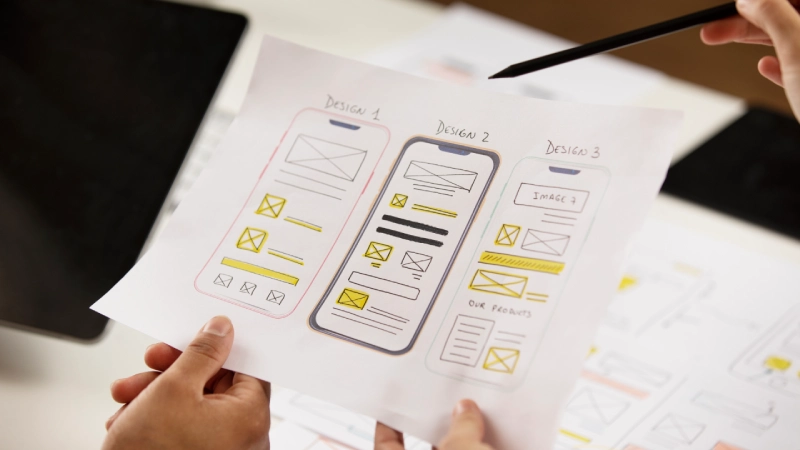In boardrooms across every industry, leaders are still asking the same tired question: “What’s the ROI on design?” And too often, the unspoken belief behind it is that design and development are cosmetic upgrades—nice-to-haves, not need-to-haves. That mindset doesn’t just miss the point; it creates business problems that ripple far beyond the marketing department.
Design and development aren’t decorations. They’re the infrastructure of how your company shows up in the world. They influence whether your tools work, whether your brand feels credible, and whether your customers stick around long enough to care. Here’s what more CEOs and CFOs are starting to recognize when it comes to design and development—and why these should be line items, not leftovers.

Table of Contents
Mobile Isn’t Just a Channel—It’s the Front Door
Any company still underestimating the power of mobile is years behind. From customer acquisition to post-sale engagement, mobile-first interaction is now the rule, not the exception. Whether it’s checking out a product, booking a service, or reviewing a dashboard, most users expect it all to work seamlessly on their phone—and they won’t wait around if it doesn’t.
The science behind mobile app development shows just how strategic the process really is, from architecture and user flow to performance and personalization. The value isn’t just in having an app. It’s in having an app that supports your business logic, helps you collect clean data, and gives users a reason to return.
When you invest in mobile design and development early, you’re building a channel that scales. It supports retention, drives recurring revenue, and reinforces your brand wherever your customers go. Treating mobile as a side project or something to figure out later doesn’t just delay growth—it undercuts your credibility from the start.
The Right Design Partner Helps You Build Assets, Not Expenses
When it comes to development and design, not all vendors are created equal. That’s why more companies are choosing to work with trusted companies like Adchitects, who understand the needs of larger businesses and also focus on building digital assets that actually contribute to the bottom line. This isn’t about surface-level polish—it’s about strategic execution.

These companies approach every project with business outcomes in mind. That means understanding user behavior, building architecture that supports scalability, and integrating tools that keep your operations efficient. Their work reflects the idea that good design doesn’t just look nice. It performs. It supports conversion, improves engagement, and delivers measurable returns.
This kind of partnership changes the conversation. Instead of fighting to justify every design dollar, you start to see design and development as multipliers—parts of your business that enable sales, drive growth, and reduce friction across departments. When you work with experts who understand how to align visuals with function and brand with business logic, you’re investing in a tool that pays you back.
Design Isn’t Decoration. It’s Infrastructure.
Too often, companies slap design on at the end of a project—once the product is built, the backend is done, and the developers are wrapping up. But smart teams bring design in early because they know that visuals, UX, and content aren’t just wrappers. They affect how the product functions, how users behave, and how systems interact.

Think about what happens when poor design slows down user onboarding, increases support requests, or confuses visitors into bouncing. That’s wasted money. Not just in missed revenue but in added costs—more customer service hours, more churn, more abandoned carts.
Design is infrastructure. It sets the tone, structure, and usability for everything else. From navigation to conversions to retention, good design quietly does the heavy lifting. When you treat it as such, you stop seeing it as “optional polish” and start seeing it as what it really is: a critical business function.
Bad Development Always Costs More in the Long Run
Cutting corners on development may feel like a smart move in the short term, but the consequences always catch up. Sites that aren’t built with scalability in mind start to buckle under growing traffic. Apps that aren’t coded for flexibility become rigid and costly to update. Internal tools that lack integration become data silos no one wants to fix.
The cost of rework is real. And while patching up tech debt might be a familiar cycle, it’s a completely avoidable one. Investing in thoughtful, well-documented, standards-based development from day one means your digital products can grow alongside your business, not work against it.

Design Drives Trust—And Trust Drives Conversion
Trust is crucial in business. There’s a reason people instinctively back out of poorly designed websites, even if the product is solid. In today’s market, users judge legitimacy fast. If your design feels off, clunky, or outdated, it signals something deeper: that your company might not be serious. That impression forms in seconds, and recovering from it is difficult, even with follow-up campaigns and great customer service.
Design affects first impressions, which means it also affects conversion rates, email signups, demo requests, and completed checkouts. A clean, intentional, well-branded interface builds trust without words. It gives users the confidence that they’re in the right place, dealing with a credible business, and safe to take the next step.